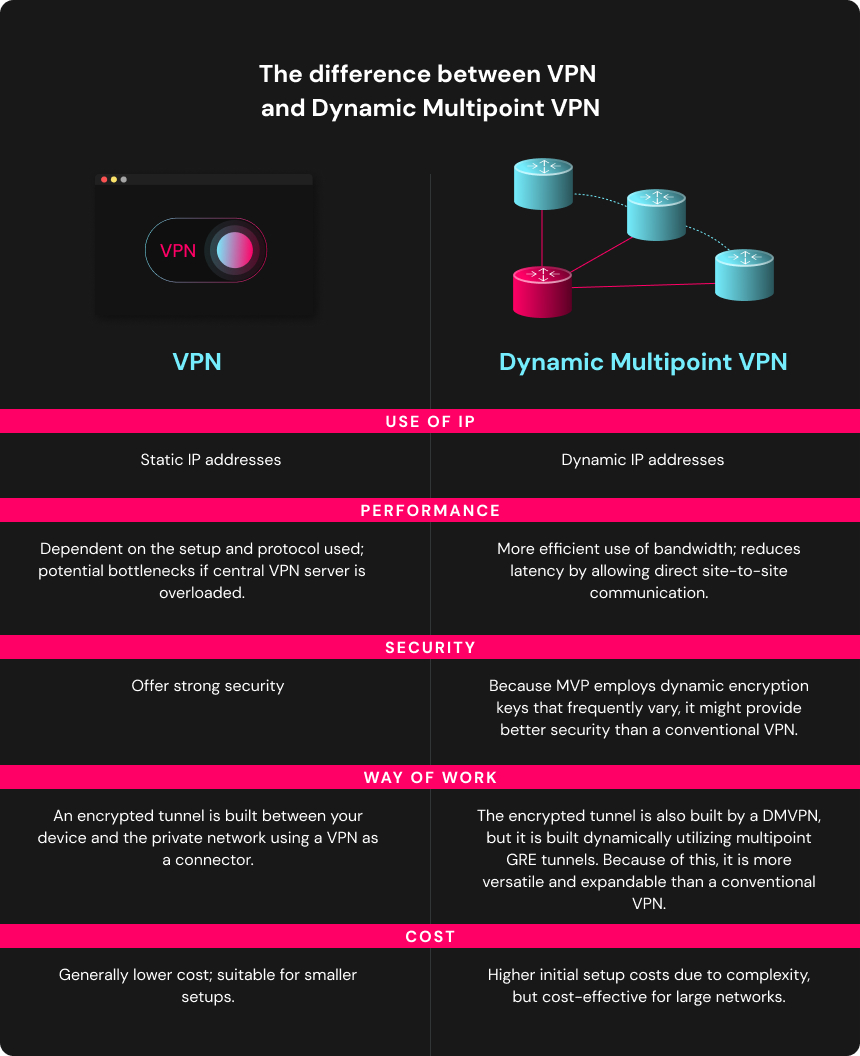A DMVPN makes internal networks redundant by allowing branch sites to share communication resources with one another directly &securely through public WAN or internet connection. It accomplishes this without establishing a constant VPN connection between the multiple sites instead of using a centralized architecture that can implement VPN security and granular access controls when needed.
As a result, it uses the security characteristics of a VPN more selectively when communications are open, or access must be provided to particular digital resources. DMVPN incorporates communication channels into VPN security, including the VoIP system.

What is the difference between VPN and Dynamic Multipoint VPN?
The following are some of the differences between VPN and Dynamic Multipoint VPN:
1. Use of IP
A significant distinction between a VPN and DMVPN is that the latter employs dynamic IP addresses instead of static ones. Since the address is continually changing, it is more difficult for someone to spy on data as it moves between devices. A regular VPN normally only permits one-to-one connections; however, DMVPN allows for connecting numerous sites.
2. Performance
Performance is a further distinction between DMVPNs and VPNs. Due to the fact that all traffic must pass via the VPN server, VPN connections might cause Internet connection slowdowns. As a result of direct data transmission, performance on the network can be greatly enhanced.
3. Security
The two types of VPNs and DMVPNs also differ slightly in terms of security. In terms of protection from eavesdropping and other assaults, both kinds of networks offer strong security. However, because MVP employs dynamic encryption keys that frequently vary, it might provide better security than a conventional VPN.
4. Way of Work
An encrypted tunnel is built between your device and the private network using a VPN as a connector. As it moves back and forth between you and the network, this tunnel shields your data from prying eyes. The encrypted tunnel is also built by a DMVPN, but it is built dynamically utilizing multipoint GRE tunnels. Because of this, it is more versatile and expandable than a conventional VPN. DMVPN also uses the benefits of mGRE (multipoint GRE), which enables numerous spokes to connect without requiring a full mesh architecture.
5. Cost
In terms of price, VPNs are frequently less expensive than DMVPNs. This is due to the fact that DMVPN necessitates specialized hardware and software, which might raise the network’s overall cost. VPNs are more cost-effective for firms with limited resources because they can be set up utilizing existing gear and software.
What is DMVPN used for?
The DMVPN is a flexible tool that can be applied to numerous situations.
- Making a secure VPN tunnel between two or more sites is one of DMVPN’s most well-liked applications. Businesses with several sites that need to be securely connected to one another frequently employ this type of system
- Accessing a private network from a public one is another frequent application of DMVPN. When workers need to access their company network when they are out of the office, this can be helpful. Additionally, it can be utilized to grant partners or clients access to a private network without revealing the complete infrastructure to them
- Finally, DMVPN can be used to establish a backup network connection. In the event that the primary connection is compromised, this configuration offers an additional level of security. By providing customers with alternate routes to travel in the event that one path gets clogged, it can also aid in performance improvement
What is the difference between DMVPN and IPSEC?
Regarding redundancy, DMVPN can be seen as an advancement over the IPsec tunnel as a whole. In contrast to IPsec VPN tunnels, which are pre-built and essentially “nailed together” between two locations, DMVPN creates tunnels as needed. In contrast to SD-WAN, it does this utilizing standard routers without the option to add further features.
As opposed to hub-and-spoke networks, DMVPN tunnels are constructed as a mesh network. As a result, DMVPN is no longer constrained to route traffic through a hub location first when transporting data between remote sites. Instead, it can do so directly. If more than one WAN connection is put there, it can also route outward packets across broken WAN lines when they go down.
When you want to establish transport efficiencies between faraway locations but don’t require the low-latency breakthroughs seen in SD-WAN, this kind of WAN design is ideal. But keep in mind that DMVPN’s routing method relies on dynamic routing protocols. When managed improperly, improper usage of dynamic routing protocols can result in major security and reliability problems. Additionally, it somewhat increases configuration complexity. Building DMVPN tunnels between networks you don’t completely administer are therefore not recommended.
Remote site communication used to be dominated by IPsec VPN tunnels. When compared to private WAN connectivity choices like MPLS, IPsec tunnels were incredibly inexpensive since network administrators could construct them via affordable broadband internet cables. Additionally, they are simple to set up, and almost anyone can purchase inexpensive hardware to create an IPsec tunnel, including basic firewalls and routers.
The drawback of IPsec tunnels is that they link two sites together. IPsec could be used, for instance, to link two routers in a site-to-site network. In huge organizations with thousands of sites, where thousands of connections may need to be made, that does not scale effectively.
An alternative is provided by Dynamic MultiPoint VPN (DMVPN) technology. Sites can connect to the DMVPN hub router utilizing dynamic IP addresses thanks to this.
Conclusion
DMVPN is a more adaptable virtual private network solution since its tunnels don’t have to endure indefinitely. A spoke-to-spoke link that isn’t in use after a predetermined time will be dropped. There isn’t only one VPN solution with one always-open tunnel for one user; any router with the proper DMVPN configuration can connect to the main router. DMVPN is a viable option for companies with numerous locations and a large workforce.
For a network with numerous linked routers, DMVPN also offers decreased latency.
Additionally, it is scalable for companies that need to expand and keep adding connections.
